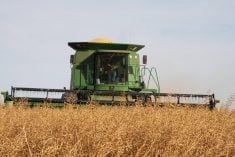All you need to do to track grain market direction these days is watch the weather forecast for the American Midwest and Canadian Prairies.
Rarely has it dried up enough to make much harvest progress. The forecast for the Prairies was for drier conditions this week, but in the U.S. Midwest rain was in the outlook.
While about 20 percent of Canadian canola was left to harvest, only 30 percent of U.S. soybeans had been harvested as of Oct. 18, up from 23 percent the week before but well down from last year’s 64 percent and the five year average of 72 percent.
Read Also

Taking a look inside Canada’s seed regulatory overhaul
ive years, eight task teams, 130 volunteers and 135 recommendations later, Canada’s seed industry is still waiting for meaningful regulatory change.
Only 17 percent of the corn crop had been harvested, up from 13 percent the week before but down from last year’s 28 percent and the historical average of 46 percent.
Rising investor confidence in the global economic recovery is also supporting grain prices. Money that was on the sidelines, stashed in U.S. dollars, is shifting into equity and commodity markets.
The Dow pushed past the psychologically important 10,000 mark last week.
Oil in New York rose to more than $79 US per barrel Oct. 19 as investors ignored ample supply and focused instead on expectations of rising demand.
Managed investment funds have moved net long in soybeans and corn, meaning they are betting on prices rising.
As money flows out of the U.S. dollar, its value relative to other currencies falls.
The weak greenback raises hopes that importers with stronger currencies will see U.S. grain as a bargain and buy more.
Barring a rapid and sustained move toward better U.S. weather, or a deflation of investor confidence, it looks like the 2009 harvest price lows have been reached.














